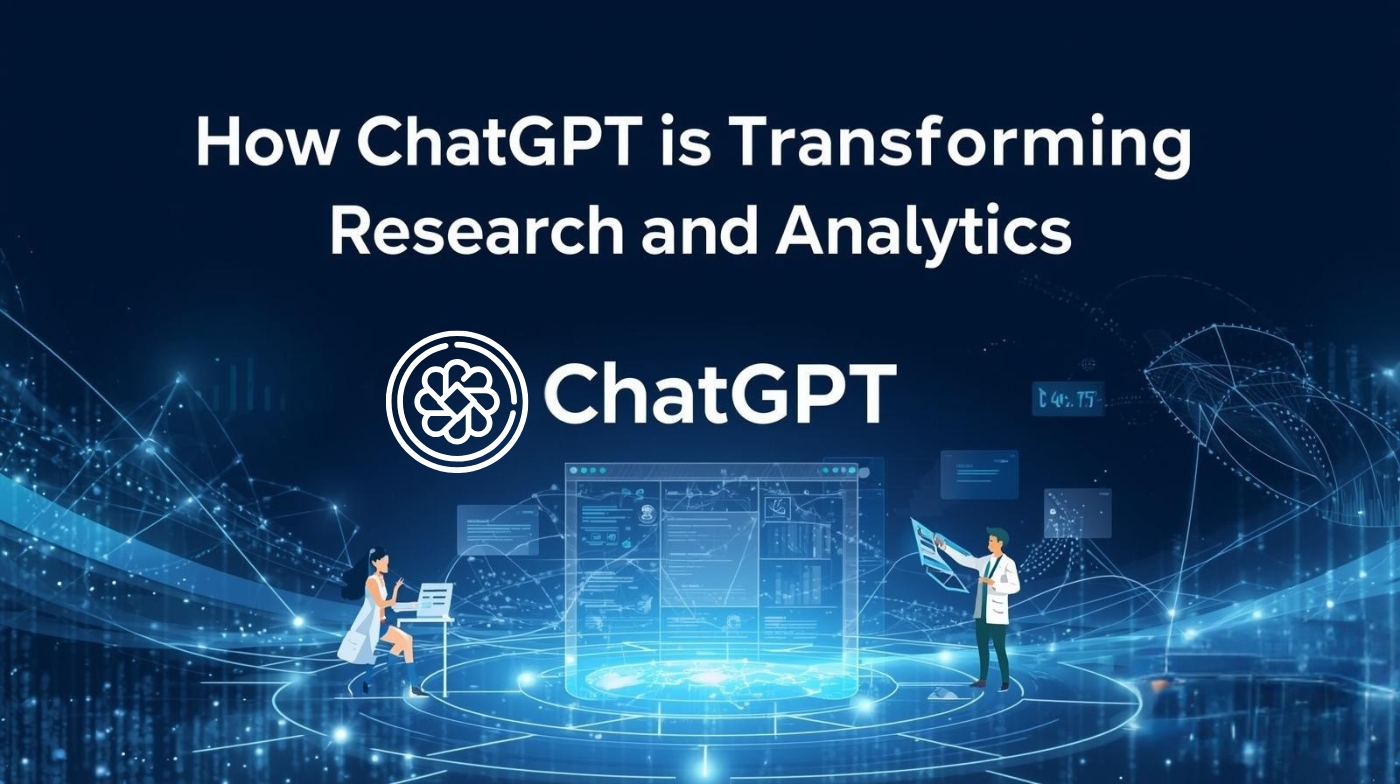How ChatGPT is Transforming Research and Analytics

Introduction
Artificial Intelligence is no longer science fiction—it’s part of our daily lives. From voice assistants to recommendation engines, AI powers much of what we interact with online. Among the most impactful AI tools today is ChatGPT, a large language model that understands, processes, and generates human-like text. Beyond casual conversations, ChatGPT is transforming the way researchers and analysts work, speeding up processes that once took hours—or even days.
This blog explores how ChatGPT is reshaping research and analytics, its real-world applications, limitations, and the future of AI-powered knowledge discovery.
What is ChatGPT?
ChatGPT is an advanced AI developed by OpenAI. It uses deep learning and natural language processing (NLP) to understand context and generate human-like responses. Unlike search engines that point you to existing content, ChatGPT can summarize, explain, brainstorm, and even create new narratives based on existing knowledge.
For researchers and analysts, this means less time spent sifting through piles of documents and more time focusing on insights and strategy.
How ChatGPT Supports Research
- Summarization: Quickly condenses lengthy reports, research papers, or articles.
- Brainstorming: Generates new ideas and perspectives for framing research questions.
- Literature Review: Provides structured overviews of existing studies.
- Drafting Content: Assists in writing research papers, reports, and presentations.
- Language Translation: Helps researchers work across multilingual sources.
Instead of replacing researchers, ChatGPT serves as a powerful assistant, handling repetitive tasks while humans focus on critical thinking.
How ChatGPT Enhances Data Analytics
- Data Cleaning Guidance: Provides step-by-step instructions for cleaning and organizing datasets.
- Explaining Complex Concepts: Breaks down statistical models, algorithms, or data science methods in simple terms.
- Code Assistance: Suggests Python, R, or SQL scripts for analysis.
- Hypothesis Testing Support: Helps analysts frame tests and interpret results.
- Visualization Ideas: Recommends effective ways to present findings with charts or dashboards.
Case Study: Academic Research with ChatGPT
A group of graduate students used ChatGPT during their thesis work. Instead of spending weeks compiling literature reviews manually, they used the tool to summarize dozens of papers, identify common themes, and generate outlines. This freed up more time for actual experiments and analysis. The result? Faster progress, deeper insights, and a more polished final submission.
Case Study: Business Analytics with ChatGPT
An e-commerce company integrated ChatGPT into its analytics workflow. Analysts used it to generate Python code snippets for data cleaning, create explanations for executive reports, and even simulate customer behavior scenarios. By using ChatGPT as a support system, the analytics team reduced project turnaround times by nearly 40%.
Benefits of Using ChatGPT in Research and Analytics
- Speed: Accelerates repetitive tasks like summarization and code generation.
- Accessibility: Makes complex data concepts understandable to non-experts.
- Creativity Boost: Generates fresh perspectives and alternative approaches.
- Collaboration: Acts as a “thinking partner” for brainstorming sessions.
- Scalability: Handles large volumes of text or queries efficiently.
Challenges and Limitations
- Accuracy Issues: ChatGPT may produce incorrect or outdated information.
- Bias in Responses: AI models reflect biases present in their training data.
- Over-Reliance: Researchers may skip critical validation if they trust AI blindly.
- Privacy Concerns: Sensitive data should not be shared without safeguards.
- Context Gaps: While ChatGPT understands patterns, it lacks real-world judgment.
Best Practices for Using ChatGPT Effectively
- Verify Information: Always cross-check AI outputs with credible sources.
- Use as a Supplement: Treat ChatGPT as an assistant, not a replacement.
- Ask Specific Questions: The more precise the query, the better the response.
- Combine with Analytics Tools: Pair ChatGPT with visualization platforms or coding tools.
- Stay Ethical: Avoid using ChatGPT to fabricate or misrepresent data.
Future of ChatGPT in Research and Analytics
The role of ChatGPT is only beginning. In the future, we can expect:
- Deeper Integration: ChatGPT embedded directly into analytics platforms like Tableau or Power BI.
- Domain-Specific Models: AI fine-tuned for medicine, law, finance, and academia.
- Real-Time Collaboration: Teams using ChatGPT in live research and brainstorming sessions.
- Predictive Analysis Support: AI helping researchers test hypotheses faster with simulated models.
As AI evolves, ChatGPT will become an indispensable tool, transforming how humans interact with knowledge.
FAQs on ChatGPT in Research and Analytics
Q1: Can ChatGPT replace researchers and analysts?
No. It’s a support tool, not a substitute for human judgment and expertise.Q2: Is ChatGPT reliable for academic work?
It’s useful for summaries and drafts but always requires fact-checking with peer-reviewed sources.Q3: Can ChatGPT analyze raw data directly?
Not yet in most cases—it helps by generating code and explanations, but specialized analytics tools handle raw data.
Conclusion
ChatGPT is transforming the research and analytics landscape by accelerating tasks, simplifying complex processes, and enabling greater creativity. However, its role is complementary, not substitutive. True breakthroughs still require human curiosity, ethical judgment, and domain expertise. By treating ChatGPT as a powerful assistant rather than a replacement, researchers and analysts can save time, boost productivity, and focus on what really matters: generating insights that shape the future.The future of knowledge work lies in the partnership between human intelligence and artificial intelligence—and ChatGPT is at the forefront of this evolution.







